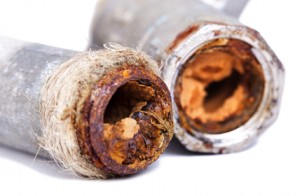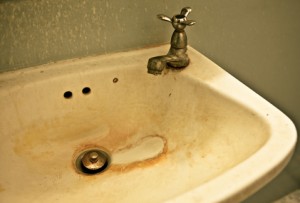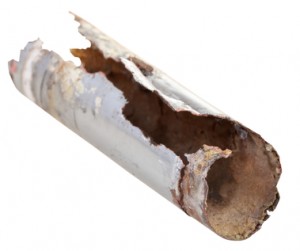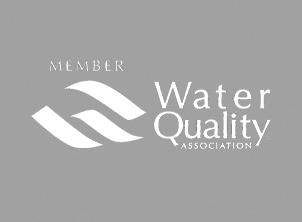Water Problems
Bottle Free Water will provide you with a FREE WATER ANALYSIS and can offer you a solution for whatever your water problems may be. Contact us and schedule a no cost visit today.
Hard Water
Hard water is a very common problem, affecting water in more than 85% of the country. Hard water is water that has high mineral content. It is formed when water percolates through deposits of calcium and magnesium-containing minerals such as limestone, chalk and dolomite. With an increase in these minerals, the following are seen:
- Soap scum in sinks and bathtubs
- Bathtub rings
- Spots on dishes or shower doors
- Reduced foaming and cleaning abilities of soaps and detergents
- Dingy and yellowed clothes with soapy residues that require extra rinsing to remove
- Clogged pipes from buildup of minerals
- Increased water heating costs from buildup of minerals, reducing efficiency of water heaters
 Hard water is often indicated by a lack of suds formation when soap is agitated in water, and by the formation of limescale in water using appliances, fixtures, and water heaters. With hard water, soap solutions form a white precipitate (soap scum) instead of producing lather, A major component of such scum is calcium stearate, which arises from sodium stearate, the main component of soap.
Hard water is often indicated by a lack of suds formation when soap is agitated in water, and by the formation of limescale in water using appliances, fixtures, and water heaters. With hard water, soap solutions form a white precipitate (soap scum) instead of producing lather, A major component of such scum is calcium stearate, which arises from sodium stearate, the main component of soap.
Hardness can thus be defined as the soap-consuming capacity of a water sample, or the capacity of precipitation of soap as a characteristic property of water that prevents the lathering of soap.
Hard water also forms deposits that clog plumbing. These deposits, called “scale”, are composed mainly of calcium carbonate, magnesium hydroxide, and calcium sulfate. Calcium and magnesium carbonates tend to be deposited as off-white solids on the inside surfaces of pipes and heat exchangers. The resulting build-up of scale restricts the flow of water in pipes. In water heaters, the deposits impair the flow of heat into water, reducing the heating efficiency and allowing the metal boiler components to overheat.
Chlorine Taste and Smell
 It is absolutely essential that drinking water should be safe to drink and contain no harmful bacteria capable of causing diseases. Chlorine has been proven to be the simplest and most effective means of disinfecting water. The addition of chlorine at water treatment plants disinfects the supply and leaves a lasting residual that keeps the water safe until it reaches your tap. If tap water has a distinct taste and smell of chlorine it usually means there is a high chlorine residual in the water—maybe not above the maximum containment level of 4.0 mg/l or ppm, but high enough that the person finds it offensive to the taste. It dries out your skin and hair, as well as it alters the taste of your drinks, like tea and coffee.
It is absolutely essential that drinking water should be safe to drink and contain no harmful bacteria capable of causing diseases. Chlorine has been proven to be the simplest and most effective means of disinfecting water. The addition of chlorine at water treatment plants disinfects the supply and leaves a lasting residual that keeps the water safe until it reaches your tap. If tap water has a distinct taste and smell of chlorine it usually means there is a high chlorine residual in the water—maybe not above the maximum containment level of 4.0 mg/l or ppm, but high enough that the person finds it offensive to the taste. It dries out your skin and hair, as well as it alters the taste of your drinks, like tea and coffee.
Chlorine has several negative effects on your home. Its a strong oxidant that quickly destroys plastic and rubber components. Rubber seals and gaskets in appliances and plumbing fixtures suffer from chlorine in water too. Oxidized rubber is mushy. It can’t create a good seal. Many people have experienced a leaky toilet or faucet. This is often caused by chlorine.
Tastes and Odors
 If odor occurs in all water faucets, the problem is probably in the main water supply. Foul-smelling or bad-tasting water are signs of impurities. Here are common water odor or taste problems you might encounter:
If odor occurs in all water faucets, the problem is probably in the main water supply. Foul-smelling or bad-tasting water are signs of impurities. Here are common water odor or taste problems you might encounter:
- A rotten-egg or sulfur smell or taste suggests the presence of hydrogen sulfide. That’s often caused by a certain type of bacteria in the water. Sulfates can also cause the water to taste salty. Investigate further to pinpoint the source, such as bacteria growing in drains, water heaters, wells, or on the inside of pipes.
- Musty, earthy odors and tastes may signal dissolved solids. Such aromas and tastes may be caused by decaying organic matter in the plumbing or even in the source water itself.
- Then there’s the smell and taste of chlorine. It’s there for disinfection to make water safer to drink and originates during the normal chlorination treatment process, but to enjoy the taste you may want to get rid of it.
- If water smells or tastes like turpentine or other chemicals that might indicate the presence of methyl tertiary butyl ether (MTBE) or xylenes, byproducts of gasoline refining, paints, detergents, or inks.
- Metallic smells and tastes may be a sign of mercury, lead, copper, arsenic, or iron in the water. Manganese and zinc may also cause a metallic smell or taste. These chemicals may come from the pipes themselves.
Staining
 If the stains or water are blue-green in color, then most likely, corrosion of copper is occurring within the household plumbing caused by low pH.
If the stains or water are blue-green in color, then most likely, corrosion of copper is occurring within the household plumbing caused by low pH.
Stains that are various shades of yellow, tan, brown, orange, or red can indicate the presence of iron.
While iron serves as essential nutrient for your body, it isn’t so kind to plumbing fixtures, appliances and even clothing. Iron in water can cause yellow, red, or brown stains on laundry, dishes, and plumbing fixtures such as sinks. In addition, iron can clog wells, pumps, sprinklers, and other devices such as dishwashers, which can lead to costly repairs. Iron gives a metallic taste to water, and can affect foods and beverages – turning tea, coffee, and potatoes black. Iron can occur in water in a number of different forms. The type of iron present is important when considering water treatment. Water that comes out of the faucet clear, but turns red or brown after standing is “ferrous” iron, commonly referred to as “clear-water” iron. Water which is red or yellow when first drawn is “ferric” iron, often referred to as “red- water” iron. Iron can form compounds with naturally occurring acids, and exist as “organic” iron. Organic iron is usually yellow or brown, but may be colorless. Water containing iron bacteria is said to contain “bacterial” iron.
Low pH, acidity
 When pH is low, your household plumbing pipes may leach copper into the water causing green stains on bathroom sinks and porcelain surfaces. The water itself may also appear to have a blue-green tint. Water with a pH under 7 (acidic water) is not necessarily harmful to your health. Many of our foods and beverages like Orange Juice, Vinegar, and Coffee have low pHs. Most well water in our area has a pH from 5.0-6.5. The health concern is what could be dissolving into your water. Copper, lead, cadmium, chromium and zinc are used in our plumbing, well pumps, fixtures and pressure tanks.
When pH is low, your household plumbing pipes may leach copper into the water causing green stains on bathroom sinks and porcelain surfaces. The water itself may also appear to have a blue-green tint. Water with a pH under 7 (acidic water) is not necessarily harmful to your health. Many of our foods and beverages like Orange Juice, Vinegar, and Coffee have low pHs. Most well water in our area has a pH from 5.0-6.5. The health concern is what could be dissolving into your water. Copper, lead, cadmium, chromium and zinc are used in our plumbing, well pumps, fixtures and pressure tanks.
Acidic water will cause problems to your home’s plumbing and appliances. Over time the acid will eat away at copper plumbing, which weakens the pipe lining and causes pinhole leaks. Acidic water will also corrode appliances like your hot water heater, dishwasher, sinks, faucets, toilet fixtures and washing machines. Corrosion will slowly occur when acidic water is in contact with any metals in the home.






